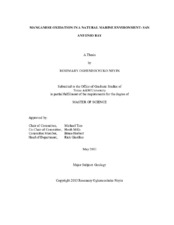| dc.contributor.advisor | Tice, Michael M | |
| dc.contributor.advisor | Mills, Heath | |
| dc.creator | Neyin, Rosemary Ogheneochuko | |
| dc.date.accessioned | 2013-10-03T15:06:22Z | |
| dc.date.available | 2013-10-03T15:06:22Z | |
| dc.date.created | 2013-05 | |
| dc.date.issued | 2013-04-12 | |
| dc.date.submitted | May 2013 | |
| dc.identifier.uri | https://hdl.handle.net/1969.1/149533 | |
| dc.description.abstract | In the modern ocean, manganese is oxidized over a timescale of days. To better understand the mechanisms and driving factors for manganese oxidation in the natural environment, experiments were performed with surface water samples collected from the San Antonio Bay. In this study area, the formaldoxime assay was utilized to determine that manganese oxidation is catalyzed via multiple pathways utilizing various catalysts and proximal oxidants. The contribution of catalysts such as colloidal matter, microorganisms and the proximal oxidant superoxide were investigated in the San Antonio Bay. The study suggests that superoxide contributed about 30% of Mn oxidation. The microorganisms and colloids were equal in terms of catalysis and accounted for approximately 100% of Mn oxidation. This study is important because gaining more understanding on the mechanisms by which Mn is oxidized will contribute to its use as a geochemical redox indicator. | en |
| dc.format.mimetype | application/pdf | |
| dc.language.iso | en | |
| dc.subject | Manganese | en |
| dc.subject | manganese oxidation | en |
| dc.subject | microcosm | en |
| dc.title | Manganese Oxidation In A Natural Marine Environment- San Antonio Bay | en |
| dc.type | Thesis | en |
| thesis.degree.department | Geology and Geophysics | en |
| thesis.degree.discipline | Geology | en |
| thesis.degree.grantor | Texas A&M University | en |
| thesis.degree.name | Master of Science | en |
| thesis.degree.level | Masters | en |
| dc.contributor.committeeMember | Herbert, Bruce | |
| dc.type.material | text | en |
| dc.date.updated | 2013-10-03T15:06:22Z | |


